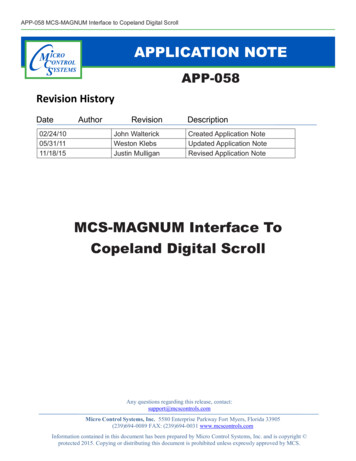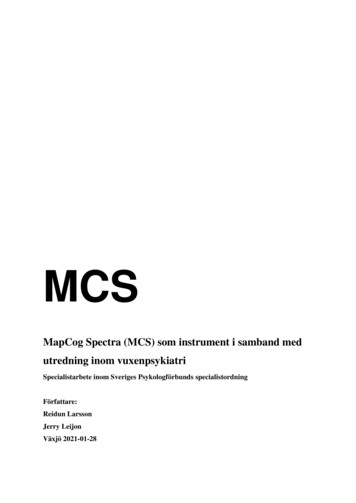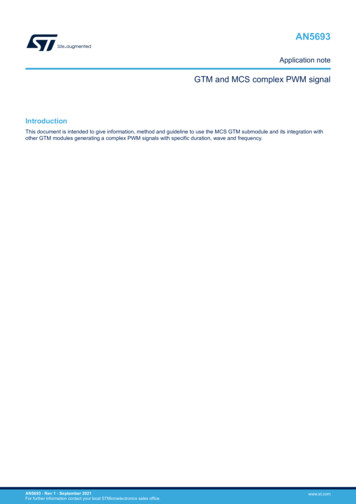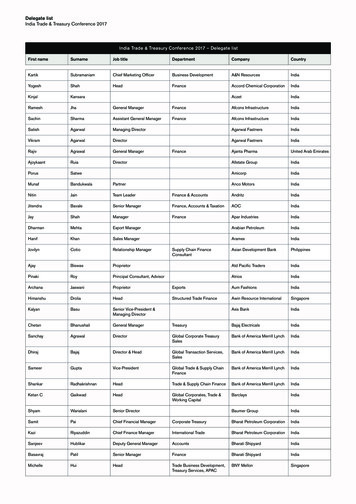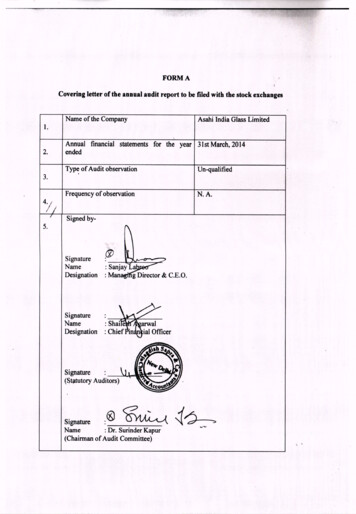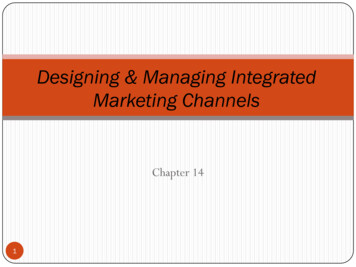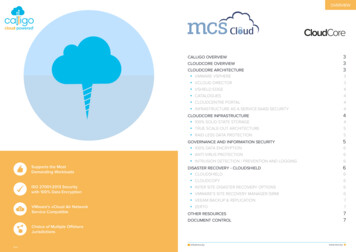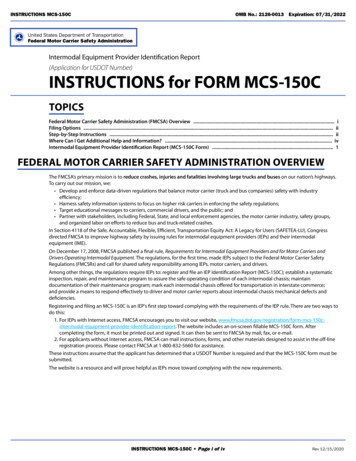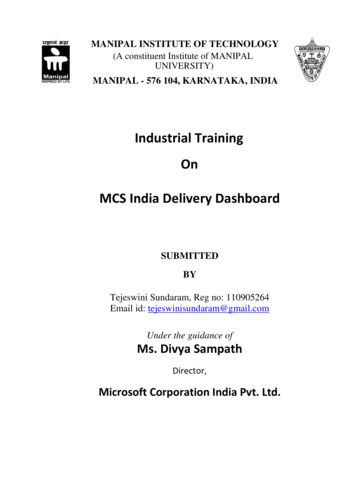
Transcription
MANIPAL INSTITUTE OF TECHNOLOGY(A constituent Institute of MANIPALUNIVERSITY)MANIPAL - 576 104, KARNATAKA, INDIAIndustrial TrainingOnMCS India Delivery DashboardSUBMITTEDBYTejeswini Sundaram, Reg no: 110905264Email id: tejeswinisundaram@gmail.comUnder the guidance ofMs. Divya SampathDirector,Microsoft Corporation India Pvt. Ltd.
TABLE OF CONTENTSTITLESL NoPg. No.1.Abstract42.Details About the Organization52.1.Microsoft India62.2.Microsoft Business Units India62.3.Vision Statement72.4.Mission Statement72.5.Microsoft Products72.6.Work Culture & Company Values73.Information acquired during the study period93.1.Project Objective93.2.Project Methodology93.2.1.Interaction with the Stakeholders103.2.2.Study and consolidation of KPI’s to the Dashboard113.2.3.Data Mapping Exercise113.2.4.Analyzing and Visualization of metrics from data113.2.5.Strategic User Flow Design112
3.2.6.Strategic Data Flow Design123.2.7.Business Requirement Document133.2.8.Implementation Phase I133.3.Project Planning133.4.Project Requirements Gathering and Analysis143.4.1.Roles/Views143.4.2.KPI Categories153.5.Project Implementation183.5.1.Microsoft ASP.NET183.5.2.C# Language193.6.Project Testing and Accommodation of ent233
1. ABSTRACTIn Management Information Systems a Dashboard is defined as an easy to read, real-time userinterface, showing a graphical presentation of the current status and historical trends of anorganization’s Key Performance Indicators (KPIs) to enable instantaneous and informeddecisions to be made at a glance. It is a visual display of the most important information neededto achieve one or more objectives; consolidated and arranged on a single screen so theinformation can be monitored at a glance.The MCS India Delivery Dashboard aims to provide a unified view of the overall health of thedelivery process at Microsoft Consulting Services (MCS), India. The main goals of the dashboardwere: To provide a customer centric delivery tracking and management view. Enable strategic decision making. Integration of financial, customer, process and people. Enable “Balanced scorecard” through metric based reports. Provide personalized view based on the user roles.In order to achieve the above goals, the concept of a balanced scorecard from the article “TheBalanced Scorecard-Measures that Drive Performance” by Robert S Kaplan and David P Nortonof The Harvard Business Review has been adopted in this project. In addition, Stephen Few’sDesign Principles as mentioned in his book “Information Dashboard Design” has beenimplemented. The Delivery Dashboard was created as a web-enabled application using VisualStudio, ASP.NET, C# Language4
2. DETAILS OF THE ORGANIZATIONMicrosoft Corporation is an American multinational corporation headquartered in Redmond,Washington, that develops, manufactures, licenses, supports and sells computer software,consumer electronics and personal computers and services. Its best known software productsare the Microsoft Windows line of operating systems, Microsoft Office suite, and InternetExplorer web browser. Its flagship hardware products are Xbox game console and the MicrosoftSurface series of tablets. It is the world's largest software maker measured by revenues. It is alsoone of the world's most valuable companies.Microsoft was founded by Bill Gates and Paul Allen on April 4, 1975 to develop and sell BASICinterpreters for Altair 8800. It rose to dominate the personal computer operating system marketwith MS-DOS in the mid-1980s, followed by Microsoft Windows. The company's 1986 initialpublic offering, and subsequent rise in its share price, created three billionaires and anestimated 12,000 millionaires from Microsoft employees. Since the 1990s, it has increasinglydiversified from the operating system market and has made a number of corporate acquisitions.In May 2011, Microsoft acquired Skype Technologies for 8.5 billion in its largest acquisition todate.As of 2013, Microsoft is market dominant in both the IBM PC-compatible operating system andoffice software suite markets (the latter with Microsoft Office). The company also produces awide range of other software for desktops and servers, and is active in areas including Internetsearch (with Bing), the video game industry (with the Xbox, Xbox 360 and Xbox One consoles),the digital services market (through MSN), and mobile phones (via the Windows Phone OS). InJune 2012, Microsoft entered the personal computer production market for the first time, withthe launch of the Microsoft Surface, a line of tablet computers.With the acquisition of Nokia's devices and services division to form Microsoft Mobile OS, thecompany will re-enter the smartphone hardware market, after its previous attempt, MicrosoftKin, which resulted from their acquisition of Danger Inc.5
2.1.Microsoft IndiaMicrosoft India Private Limited headquartered in Hyderabad, India is a subsidiary of US softwaregiant Microsoft Corporation. The company first entered the Indian market in 1990 and has sinceworked closely with the Indian government, the IT industry, academia and the local developercommunity to usher in some of the early successes in the IT market. Microsoft currently hasoffices in the 13 cities of Ahmedabad, Bangalore, Chandigarh, Chennai, Coimbatore, Hyderabad,Indore, Jaipur, Kochi, Kolkata, Mumbai, New Delhi, and Pune. Increasingly, the company hasbecome a key IT partner of the Indian government and industry, supporting and fueling thegrowth of the local IT industry through its partner enablement programs. Since its entry intoIndia, Microsoft has focused on three key objectives: To become a key IT partner of the Indian government and the local IT industry To support and fuel growth of the local IT industry through its partner enablementprograms To use the Microsoft Unlimited Potential program to enhance education, jobs andopportunities and foster innovation through relevant, affordable access to computing. Microsoft in India employs about 5,000 people and has six business units representingthe complete Microsoft product portfolio.2.2.Microsoft Business Units in IndiaMicrosoft runs the following six major business units representing our entire product cycle toserve customers from consumers to corporations, gamers to governments. Individual butconnected, our businesses are responsible for their growth while also contributing to eachother’s success. Microsoft India Sales Marketing and Services Group (SMSG) Microsoft Research India (MSR) Microsoft Global Services India (MGSI) Microsoft India Development Center (MSIDC)6
Microsoft IT India (MSIT) and Microsoft Global Technology Support Center (GTSC)2.3.Vision StatementGlobal diversity and inclusion is an integral and inherent part of our culture, fueling our businessgrowth while allowing us to attract, develop, and retain this best talent, to be more innovativein the products and services we develop, in the way we solve problems, and in the way we servethe needs of an increasingly global and diverse customer and partner base.2.4.Mission StatementThe Microsoft mission regarding global diversity and inclusion is to create an environment thathelps Microsoft capitalize on the diversity of its people and the inclusion of ideas and solutionsto meet the needs of its increasingly global and diverse customer base.2.5.Microsoft ProductsMicrosoft is the worldwide leader in software, services and solutions that help people andbusinesses realize their full potential. Microsoft offers various software and hardware products.The leading products of Microsoft are Microsoft Windows, Microsoft Office Suite, MicrosoftWindows Operating system, Microsoft Servers, Windows Developer Tools, Microsoft Expression,Business Software, Games and Xbox 360, Windows Live, Windows Phones and Apps, MicrosoftSharePoint, Microsoft Azure, Office 365, Microsoft SQL, Microsoft Visual Studio, Bing Search,Skype, Nokia Devices and more.2.6.Work Culture & Company ValuesThe Work culture at Microsoft is fast paced, challenging, and a whole lot of fun. Whether at yourworkstation, in a virtual meeting with another part of the world, or taking a coffee break withfriends, you will always find yourself collaborating, sharing new ideas and working on highimpact products and technologies that impact billions of people around the world. Working on7
products that have worldwide impact, you would be encouraged to take on big Challenges allthe time. Whether you are working on the next version of Windows, developer tools, Office orthe next generation mobile platform, it is hard to underestimate the work accomplished here.At Microsoft, the following values have been observed and followed by the employees: Integrity and Honesty Passion Accountabilities Big Challenges Open & Respectful Self-critical8
3. INFORMATION ACQUIRED DURING THE STUDY PERIOD – PROJECTDETAILSIn this section of the report, the project objectives, methodologies followed, and the variousphases of the project such as the project planning, requirements gathering and analysis, projectdevelopment, implementation and testing is discussed in detail.3.1. Project ObjectiveThe main objective of the internship project was to create/implement the MCS India deliverydashboards for customer centric delivery tracking and management. A Balanced ScorecardApproach was used to implement the requirements of the organization. The Scorecard aimed atMonitoring the Delivery Health by using a consolidated view of the Key Performance Indicators(KPIs). The Dashboard showcases the required metrics analyzed from large volumes of data withappropriate Visualization and appropriate Drill down Flows.The Major Benefits of the Dashboard to the organization was as follows: Bird Eye View of the Delivery Process Time Saving for stakeholders Assistance in Decision Making Process Timely insight to the areas that require attention of the stakeholders Consolidated Month-to-Date/ Year-To-Date View of KPIs3.2. Project MethodologyThis section explains the methodology followed in executing the project to observe the desiredresults. The Methodology followed to create the MCS India Delivery Dashboard consists of eightsteps. The steps were decided based on the requirement for the project development. Figure 1depicts the project methodology implemented graphically.9
Figure 1. Project Methodology3.2.1. Interaction with the StakeholdersThe first step of the Project involved the Interaction with the Stakeholders to understand theindividual requirement of each stakeholder and the issues faced in the existing reportingsystem. During the interaction, various aspects of the project was discussed such as the deliveryprocess and life cycle, involvement in the delivery process, roles and responsibility,organizational structure and the various Key Performance Indicators that play a part in thedecision making process.10
3.2.2. Step 2: Study and Consolidation of KPIs into a Balanced ScorecardAfter obtaining a list of the KPIs required, a study of the KPIs and their consolidation intodifferent categories for better data visualization was done. A comparison of the functionalitiesand grouping analysis was performed. The result of this step was the division of KPIs intodifferent categories. A list of KPIs per stakeholder view was also obtained after this step.3.2.3. Data Mapping ExerciseThe Mapping of the Data Sources for the various KPIs is an essential part of the implementationof the project. In this step, the metrics of the Key Performance Indicators (KPIs) and theirsources were mapped, with the help of the India and Singapore Operations Team. Along withthe Data Mapping, this step also aimed at gaining an understanding of the data retrieval,storage and updating process. Requirements gathering and sample data collection, scoping, andthe identification of functional and non-functional requirements were also performed in thisstep of the process.3.2.4. Analyzing and Visualization of Metrics from DataThe process of analysis and visual monitoring involves a series of sequential steps that thedashboard should be designed to support. To Begin with, an analysis of the KPIs and theirmetrics to be depicted on the dashboard was performed. The mathematical calculation of themetrics was also identified. Once the metrics were determined, the design and visualization ofthe KPIs and their associated metrics was looked upon. A Balanced Scorecard representationwas used in the design.3.2.5. Strategic User Flow DesignThe User Flow model for the access of the MCS India Delivery Dashboard was determined in thisstep. A top-down approach was implemented for the User flow. The User Flow Diagram is asshown in Figure 2.11
Figure 2.User Access and Flow Design3.2.6. Strategic Data Flow DesignA Bottoms-Up approach was implemented for the Data flow. The roll up of the data from thesource to the metrics representation on the dashboard was determined in this step. The DataFlow for the 19 Identified KPIs was designed. The Data Flow Diagram is as shown in Figure 3.Figure 3. Data Flow Diagram12
3.2.7. Business Requirement DocumentThe purpose of the Business Requirements Document (BRD) is to articulate the detailed to-beprocess vision and translate that vision into specific requirements for the solution. The BusinessRequirement Document was formulated for all the stakeholders’ views.3.2.8. Implementation Phase1 of the MCS India Delivery DashboardIn this Step the front-end and the initial phases of the backend of the MCS India DeliveryDashboard for the sample data obtained was created. The Dashboard was implemented inASP.NET and C# using Visual Studio. The Database was designed using SQL. The ImplementationPhase1 implemented the Dashboard for different views of the stakeholders.3.3. Project PlanningThe Project Plan was created using Microsoft Project 2013 application software. MicrosoftProject 2013 is a project management software program, developed and sold by Microsoft,which is designed to assist a project manager in developing a plan, assigning resources to tasks,tracking progress, managing the budget, and analyzing workloads. Figure 4 depicts theimplementation plan for the MCS India Delivery.Figure 4. Gantt Chat of the Implementation Plan13
3.4. Project Requirement Gathering and AnalysisThe Requirements and the sample data was gathered from their data sources by using theresults of the Data Mapping Exercise. Scoping was performed on the gathered data. The datawas then analyzed using Microsoft Excel. The BI tools offered in Microsoft Excel was made useof for the analysis. The required mathematical calculations and metrics extraction wasperformed on the data. The Functional and Non-Functional Requirements of the Dashboard wasidentified after Analysis of the data.The MCS India Delivery Dashboard represents / displays multiple KPI (Key PerformanceIndicators) and the KPI’s are grouped under different categories. The following section providesthe list of the categories and their respective KPI’s. The KPI and their category mapping differsbased on the user logged in to the dashboard.3.4.1. Roles/ViewsThe MCS India Delivery Dashboard has been designed for the following stake holders. Each stakeholder directly maps to an organizational level at which MCS is managed.RoleDescriptionDelivery LeadDelivery lead leads the MCS organization and multiple deliverymanagers reports to the Delivery LeadDelivery ManagerDelivery manager oversees set of Engagement managers andmultiple engagement managers reports to Delivery ManagerEngagement ManagerEngagement manager manage multiple accounts. Under eachaccounts there are multiple projects / engagements.Project ManagerProject manager manage multiple projects / engagements.14
3.4.2 KPI CategoriesThe Dashboard contains the following KPI categories and they’re as follows: FinanceCustomerDelivery PartnersDelivery/Engagement/Project HealthPeople/MyselfMultiple KPI’s are grouped under the above categories in Tiled format and their respective isdisplayed to the logged in user. The KPI value will differ based on the logged in user and theirprofile. Also, the KPI grouping will also differ based on the user logging in and their profile.3.4.2.1. FinanceThe Finance category contains the KPI’S (Backlog, Billed Revenue, New Work Sold, DeliveryMargin, Risk Reserve and EAC Variance from Budget). The KPI’s are displayed based on the roles,the following matrix provides the mapping between the KPI’s and the roles & their access.RolesBacklogBilledNWSRevenueDeliveryRisk ReserveMarginEAC Variancefrom BudgetDelivery Lead Delivery ManagerEngagementManagerProject ManagerNote: - Indicates that the role doesn’t have access to the KPI and it would not be visible on the screen - Indicates that the role have access to the KPI and it would be visible on the screen15
3.4.2.2. CustomerThe customer category contains the KPI’S (CPE, Forecasted Surveys, Change Management, andEAC Variance from Schedule). The KPI’s are displayed based on the roles, the following matrixprovides the mapping between the KPI’s and the roles & their access. For more information onRoles refer to role section in the ntVariancefromScheduleDelivery Lead Delivery ManagerEngagementManagerProject Manager3.4.2.3. Delivery PartnerThe Delivery Partners category contains the KPI’S (Circle of Excellence and Global Delivery). TheKPI’s are displayed based on the roles, the following matrix provides the mapping between theKPI’s and the roles & their access. For more information on Roles refer to role section in thedocumentRolesCOEGDDelivery Lead Delivery ManagerEngagementManagerProject Manager16
3.4.2.4. Delivery/Engagement/Project HealthThis category contains the KPI’S (Planned Vs Actual Hours, IP Utilization, POEC and Issuetracking). The term “Delivery Health” is used to describe this category for the Delivery Lead andDelivery Manager. While the term “Engagement Health” and “Project Health” is used for theEngagement Manager and Project Manager respectively. The KPI’s are displayed based on theroles, the following matrix provides the mapping between the KPI’s and the roles & their access.For more information on Roles refer to role section in the document.RolesPlannedIPVs ActualutilizationPOECIssueTrackingHoursDelivery Lead Delivery ManagerEngagementManagerProjectManager3.4.2.5. People/MyselfThis category contains the KPI’S (Role Readiness Index, Head Count, and Overall Utilization). Theterm “People” is used to describe this category when the logged in user is either the DeliveryLead or the Delivery Manager, whereas when the logged in user is the Engagement Manager orProject Manager the term used is “Myself”. The KPI’s are displayed based on the roles, thefollowing matrix provides the mapping between the KPI’s and the roles & their access. For moreinformation on Roles refer to role section in the document17
RolesRole ReadinessHead CountOverall UtilizationIndexDelivery Lead Delivery ManagerEngagementManagerProjectManager3.5. Project Implementation Phase 1The Project was implemented using Microsoft ASP.NET and C# Language on Visual Studio. TheIIS Web Server was made use of and for the database, Microsoft SQL Server was used.3.5.1. Microsoft ASP.NETASP.NET is a unified Web development model that includes the services necessary to buildenterprise-class Web applications with a minimum of coding. ASP.NET is part of the .NETFramework, and when coding ASP.NET applications we have access to classes in the .NETFramework. We can code the applications in any language compatible with the commonlanguage runtime (CLR), including Microsoft Visual Basic and C#. These languages enable us todevelop ASP.NET applications that benefit from the common language runtime, type safety,inheritance, and so on. The Implementation of the MCS India Delivery Dashboard was doneusing the C# Language. ASP.NET MVC helps Web developers build standards-based Webapplications that are easy to maintain because it decreases the dependency among applicationlayers by using the Model-View-Controller (MVC) pattern. It also provides complete control overthe page markup. ASP.NET MVC improves testability by supporting Test Driven Development(TDD). The .NET Framework itself can be divided into three parts: The CLR: A managed execution environment that handles memory allocation, errortrapping, and interacting with the operating-system services.18
The Base Class Library An extensive collection of programming components andapplication program interfaces (APIs). Two top-level development targets One for Web applications (ASP.NET) and another forregular Windows applications (Windows Forms).The advantages offered by the .NET Framework include shorter development cycles (code reuse,fewer programming surprises, support for multiple programming languages), easierdeployment, fewer data type–related bugs due to integral type safety, reduced memory leaksthanks to the garbage collector, and, in general more scalable, reliable applications.3.5.2 C# LanguageC# is modern, high-level, multi-paradigm, general-purpose programming language for webdevelopment and building apps using Visual Studio and the .NET Framework. C# is designed tobe simple, powerful, type-safe, and object-oriented. The many innovations in C# enable rapidapplication development while retaining the expressiveness and elegance of C-style languages.C# is an object-oriented language. It supports the notion of classes and the object-orientednature of classes including encapsulation, inheritance, and polymorphism. C# also supportsinterfaces in conjunction with the .NET Common Language Runtime (CLR) garbage collection,which some feel is necessary in an object-oriented language. It also supports the notion ofindexers, which in simplified terms lets you manipulate objects as arrays and delegates, whichyou can think of as method callbacks on steroids. The .NET Framework supports consoleapplications, graphical user interface (GUI) applications (Windows Forms), browser-basedapplications (Web Forms and ASP.NET), and Web Services. C# Language is extensively used forthe development of Web Enabled Application and hence has been used in this project as well.Below is a snapshot of the implemented MCS India Delivery Dashboard for the different Views:Delivery Lead View, Delivery Manager, Engagement Manager and Project Manager. Please Notethat the source code samples have not been added in the report due to confidentialityagreement with Microsoft.19
Figure 5. Delivery Lead ViewFigure 6. Delivery Manager View20
Figure 6. Engagement Manager ViewFigure 7. Project Manager21
3.6. Project Testing and accommodation of new changesAfter the Implementation of the MCS India Delivery Dashboard, the functionalities were testedfor their performance and results. The Changes suggested by the stakeholders were noted downand implemented in this stage. A requirement for addition of two new KPIs Lead to the rearrangement and grouping of them. These changes were then reflected in both front-end andbackend. The source code was updated and the design changes were made in this step of theproject.4. CONCLUSIONMany companies have adopted the balanced scorecard approach to dashboard design forbetter performance measurement systems. Adopting these concepts provides clarification,consensus, and focus on desired improvement in performance. Companies are usingDashboards to clarify and update their strategy, communicate strategy through theirorganizational structure, align units and individual goals with the company strategy, linkstrategic objectives to long term targets and annual budgets and to conduct periodicperformance reviews. The balanced scorecard approach is well suited for organizations thatrequire timely and consolidated access to data for qualitative and actionable decision making.The dashboard puts strategy and vision, not control, at the center. It helps establishing goals forthe teams and assumes that the team makes use of it to achieve the targets by adoptingnecessary actions and changes required. It is designed in a manner to pull people to the overallvision of the organization. Senior Manager may know what the results should be, but in somesituations may have a problem in communicating it to the junior team members. TheDashboard provides a means of performance measurement and a customer centric trackingsystem that helps communicating the information much easily across the teams.This new approach to performance measurement is consistent, with initiatives underway inmany companies: cross-functional integration, customer-supplier partnerships, global scale,continuous improvement, and team rather than individual accountability .By combining the22
Financial, Customers, Delivery Partners, Delivery Health and People Information, the balancedscorecard helps the stakeholders to analyze and understand, at least implicitly manyrelationships .This understanding can help them transcend traditional notions about functionalbarriers and ultimately lead to improved decision Making and problem solving. The dashboardsand balanced scorecards keep companies looking-and-moving forward instead of backward.5. ReferencesThe Following resources were used for the reference of the project. Microsoft Developer Network Library ion Dashboard Design Book by Stephen FewThe Harvard Business Review – “The Balanced Scorecard” by Robert S Kaplan and DavidNorton.6. AcknowledgementDuring the course of my industrial internship I got an exposure to the corporate work culture. Ireceived an opportunity to adapt to the office environment and learn about real time projectmanagement and development. Working on a live project helped me gain knowledge andexperience on how projects are executed in the corporate world. As a part of my project work, Igot an opportunity to work with the MCS India lead, senior MCS folks, Finance, and Operations(India and Asia/Singapore Units).This experience has helped me shape myself in accordancewith the current industrial developments and trend. I was given freedom to analyze, developand implement my ideas in the project, and this has helped in stimulating my thought process.The internship was a good learning curve of the professional environment and overall it was avery insightful and wonderful learning experience. I would like to take this opportunity to thankthe Institute and Department of Computer Science in giving me this opportunity to do aninternship during my Summer Vacations. I would also like to extend my gratitude to MicrosoftCorporation India Pvt. Ltd, my mentors, my manager, and all Microsoft folks who helped me insuccessfully completing this project.23
This section explains the methodology followed in executing the project to observe the desired results. The Methodology followed to create the MCS India Delivery Dashboard consists of eight steps. The steps were decided based on the requirement for the project development. Figure 1 depicts the project methodology implemented graphically.

